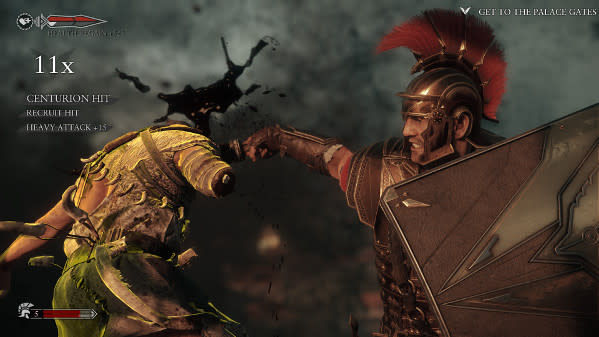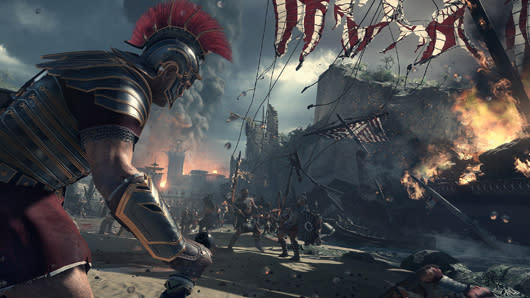Ryse: Son of Rome review: Tedious maximus
We'll be rolling out Xbox One review coverage all the way through launch on November 22. Read all of our news and reviews right here!
Ryse: Son of Rome is, graphically, a stunning game. It's a real marvel to watch gorgeous locales get flooded with hordes of barbarians jostling toward our hero, Marius Titus, who fights them off with expert swordplay and brutal executions. At first, the experience definitely has the power to enrapture.
But then, a few minutes go by and the seams start to show – and split. Combat never changes, offering all of its tricks up front. Execution animations repeat again and again, despite your ability to unlock new ones as the game progresses. The same enemy types appear ad nauseam, pitting Marius against a world-record series of twins, triplets and so on.
If Crytek's Xbox One action game is to be believed, the history books have it all wrong. The reason for Rome's fall wasn't decadence, economic problems or social division; it was sheer boredom.
Combat in Ryse: Son of Rome is simplistic: Light and heavy attacks slice up your opponents, a well-timed block will parry enemies, and a dodge button ... dodges. Simplicity in itself isn't necessarily a problem, but it becomes painfully obvious as you continue Marius' adventure that there's really nothing more to it. Though Ryse may initially look like Microsoft's foray into the realm of God of War action, Ryse lacks the same intricacy. You won't discover or unlock new combos or get any other weapons aside from Marius' sword, shield and the occasional spear – everything you have is everything you will ever have. Where Ryse puts its money is on its executions: Cut up an enemy enough and an icon will appear above his head, slam on the right trigger and a slow-mo, pseudo-QTE execution animation will begin.
As an execution animation is played, the enemy will flash a color which corresponds to a face button on the Xbox One controller. If they flash blue, for example, you hit the X button. Color blind gamers may find this system problematic, as there are no additional options for, say, button prompts instead of color highlights. Luckily, however, you don't have to press X when enemies flash blue, or any button at all, as it's impossible to fail these moments. The execution goes off without a hitch whether you get it right or not, but pressing the correct button rewards you with more points toward your selected perk. The perks are where Ryse's combat becomes slightly more engaging.
There are four perks: health regeneration, damage boost, XP gain, and focus, which slows down enemies while increasing Marius' damage and speed. Each perk is locked to a direction on the D-pad. As you fight, you can swap perks out on the fly. When you complete executions, you earn points toward that selected perk. If you're low on health, for example, select health regen (down on the D-pad) and initiate an execution. Nail the button presses in the execution animation and you'll get a large portion of your health back, miss the button presses and you'll only get a little. You also get scored higher for how quickly you respond to the prompt. Failure, then, isn't tied to combat, but rather the perk management metagame around it. You learn all of this within the first hour and although the game peppers in the occasional march with Roman soldiers or turret equipped with deadly arrows, the focus is on Marius' sword and shield. And because the combat relies so heavily on color-coding and constant parrying, Ryse is extremely easy to master.

A system based on executions isn't a bad idea, but it would have been nice to have more influence over it. Animations are randomized for the most part, meaning you have little control over which execution plays out. You have some control over the animation type, which is governed by positioning and selected perk. You can set up double executions by getting two half-dead baddies close to each other, or you can execute an enemy near environmental hazards (think: pointy things). The animations associated with these deaths, however, are random, and using your in-game credits to unlock more animations just add to what I assume is a giant wheel spinning in the background, deciding what kill you'll see next. "Oh, dodge left and stab through the back of the neck again? Thanks giant wheel, that one is my fave."
By the end of the campaign, combat in Ryse gets soul-crushingly boring: like taking a dose of NyQuil, watching Ridley Scott's Gladiator and playing a rousing game of Simon all by your lonesome.
The real disappointment is that the one-note combat bogs down what is otherwise a shining production. Discovering the battle systems at the beginning of the adventure can be exciting. The death animations, upon first viewing, are ruthless and cool. And, as I've said, Ryse is absolutely gorgeous, continuing the trend of Crytek's technical expertise stomping every other engine in existence. The game's alt-history narrative follows Roman centurion Marius Titus through a winding journey of loss and betrayal in the middle of a war between Rome and Britannia. The highlight of single-player is the performance from the game's main cast, which does its best to add weight to Ryse's predictable twists. But all the polish in the world isn't enough to prop up the combat, which failed to hold my interest throughout the short, five hour length of Ryse's campaign.

Xbox One reviews
Cooperative two-player multiplayer offers fresh ideas, but still emphasizes the game's lackluster combat against enemy AI. The mode, which can also be done solo, takes place in the Coliseum, with wildly historically inaccurate grounds that shift and change to present new maps. When a map is selected and your nameless customizable character enters the Coliseum, the ground will quake and fall out of view of the camera, only to rise again featuring new geometry and a new theme. Multiplayer offers objectives throughout rounds, each based on the map selected. Some are as simple as "kill all enemies," while others add a narrative touch with the help of an extremely enthusiastic Coliseum announcer. One map tells the story of barbarians attacking a fort by boat. Of course, there is no actual water or boat, the maps are presented like a stage, and you are one of the actors sent in to entertain the masses. To that end, there's a meter for entertainment: Kill and the Romans are enraptured, let everyone keep their precious blood and the crowd gets bored, and you lose out on coin bonuses.
Ryse features a handful of microtransactions, but isn't too abrasive about the option. It does nudge you if you're short on coin, letting you know that a quick trip to the Store will allow you to stock up on as little as 1,000 coins ($.99) or a max of 25,000 ($20). Coins are used to buy booster packs for your online character. These feature pieces of gear with unique attributes that affect your health, focus, how the crowd responds to you and more. The system gates booster packs based on tier, and that's a good thing. Rather than allowing someone to buy thirty-grand worth of coins and pick up top-tier booster packs, players must level their character up to a specific rank. From my experience, by the time I unlocked new tiers, I was rolling in coin and I never felt pushed to spend real money.
Playing online with another player doesn't add much flair to the experience, unfortunately. It's still the same combat system, save for the ability to perform combo executions. The multiplayer is extraordinarily rough around the edges, as well. Perhaps because of the ever moving and changing maps, enemies get stuck on geometry. Invisible walls may neglect to deactivate and keep you from completing objectives. Artificial intelligence is dialed back to zero in some instances, like a moment where I tricked an enemy to run right toward me to his doom, through a set of spinning blades. Sometimes enemies will freeze in place after they die or wobble around for a few moments after their death knell animation. Xbox, record that:
Ryse: Son of Rome falls into the trap of your typical launch game: it does well to show off the power of the system, but it's slim on substance. Production value aside, Ryse is short, easy and lacks the punch of other action games. For all of its pomp and flash, Ryse: Son of Rome is a shallow bore.

This review is based on final code of Ryse: Son of War, provided by Microsoft. The SmartGlass integration for this game was unavailable during the development of this review.
Joystiq's review scores are based on a scale of whether the game in question is worth your time -- a five-star being a definitive "yes," and a one-star being a definitive "no." Read here for more information on our ratings guidelines.

